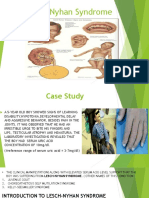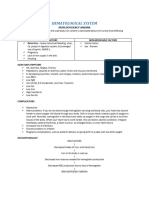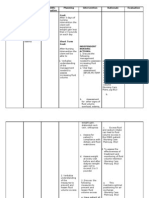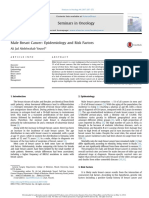0 ratings0% found this document useful (0 votes)
53 viewsAssessment: Hemochromatosis (Iron Overload)
Assessment: Hemochromatosis (Iron Overload)
Uploaded by
JuliaHemochromatosis is an iron overload condition that can cause joint pain, fatigue, liver damage, heart problems, and other issues. Patients may report joint pain, abdominal pain and fatigue. Examinations may reveal signs of liver or heart damage. Diagnostic tests show high iron levels in the blood and liver. Treatment goals are to reduce serum ferritin levels and joint pain through iron chelation medications, dietary changes to avoid iron-rich foods, and monitoring of symptoms and iron levels.
Copyright:
© All Rights Reserved
Available Formats
Download as DOCX, PDF, TXT or read online from Scribd
Assessment: Hemochromatosis (Iron Overload)
Assessment: Hemochromatosis (Iron Overload)
Uploaded by
Julia0 ratings0% found this document useful (0 votes)
53 views3 pagesHemochromatosis is an iron overload condition that can cause joint pain, fatigue, liver damage, heart problems, and other issues. Patients may report joint pain, abdominal pain and fatigue. Examinations may reveal signs of liver or heart damage. Diagnostic tests show high iron levels in the blood and liver. Treatment goals are to reduce serum ferritin levels and joint pain through iron chelation medications, dietary changes to avoid iron-rich foods, and monitoring of symptoms and iron levels.
Original Title
Hemochromatosis
Copyright
© © All Rights Reserved
Available Formats
DOCX, PDF, TXT or read online from Scribd
Share this document
Did you find this document useful?
Is this content inappropriate?
Hemochromatosis is an iron overload condition that can cause joint pain, fatigue, liver damage, heart problems, and other issues. Patients may report joint pain, abdominal pain and fatigue. Examinations may reveal signs of liver or heart damage. Diagnostic tests show high iron levels in the blood and liver. Treatment goals are to reduce serum ferritin levels and joint pain through iron chelation medications, dietary changes to avoid iron-rich foods, and monitoring of symptoms and iron levels.
Copyright:
© All Rights Reserved
Available Formats
Download as DOCX, PDF, TXT or read online from Scribd
Download as docx, pdf, or txt
0 ratings0% found this document useful (0 votes)
53 views3 pagesAssessment: Hemochromatosis (Iron Overload)
Assessment: Hemochromatosis (Iron Overload)
Uploaded by
JuliaHemochromatosis is an iron overload condition that can cause joint pain, fatigue, liver damage, heart problems, and other issues. Patients may report joint pain, abdominal pain and fatigue. Examinations may reveal signs of liver or heart damage. Diagnostic tests show high iron levels in the blood and liver. Treatment goals are to reduce serum ferritin levels and joint pain through iron chelation medications, dietary changes to avoid iron-rich foods, and monitoring of symptoms and iron levels.
Copyright:
© All Rights Reserved
Available Formats
Download as DOCX, PDF, TXT or read online from Scribd
Download as docx, pdf, or txt
You are on page 1of 3
Hemochromatosis (Iron Overload)
Assessment Patient Image: Include an image that demonstrates the patient’s
expected physical appearance
Subjective: what symptoms will the patient report? Some patients
who have hereditary hemochromatosis may not have symptoms.
➢ Joint Pain
➢ Abdominal pain
➢ Fatigue
➢ Weakness
➢ Impotence
Objective: what signs will you expect to see? What assessments
will you do? What diagnostic tests will you anticipate? What are
the expected results of those tests?
➢ In the heart: arrhythmia and heart failure
➢ In the liver: cirrhosis, enlarged liver, liver cancer, liver
failure
➢ Diabetes
➢ Assessment:
- Family history of hemochromatosis
- Skin assessment to look for bronze colored skin
- Medical history for any complications
➢ Diagnostic test:
- Total iron-binding capacity will be high (reflects
amount of transferrin, a protein that binds with iron
and transports it for storage)
- liver function test abnormal
- serum ferritin will be high (measures amount of
iron stored in liver)
- Genetic testing
Goals ● Patient will reach a serum ferritin level between 50 and 100
ng/mL.
● Patient will avoid foods rich in iron such as red meat,
vitamin C, and alcohol.
● Patient will report joint pain no higher than a 2.
Interventions ● Iron chelating agents such as Deferoxamine, Deferasirox,
(medications) and Deferiprone.
● Iron accumulation can be reduced by dietary changes, such
as avoiding vitamin C and iron supplements, uncooked
seafood, and iron-rich foods.
Rationale (what is the ● Deferoxamine, which chelates and removes accumulated
reason for the iron via the kidneys, can be given IV or subcutaneously.
intervention?)
● Deferasirox and deferiprone are oral agents that chelate
iron. Chelating agents form a complex with iron and
promote its excretion from the body.
Evaluation ● Patient is able to return to serum iron concentrations to a
normal level (50-150 mcg/100mL) keep iron serum
concentrations at a manageable level.
● Check patient’s using pain scale, and patient states of joint
pain no higher than 2.
● The patient reports understanding of changing their diet to
avoid foods rich in iron.
You might also like
- ThrombophlebitisDocument10 pagesThrombophlebitismardsz100% (3)
- Topic 8 - Anemia 3Document62 pagesTopic 8 - Anemia 3Vince Martin ManaigNo ratings yet
- 01_chan_doan_va_dieu_tri_thieu_mau_thieu_sat_cme_nmt_199201920Document44 pages01_chan_doan_va_dieu_tri_thieu_mau_thieu_sat_cme_nmt_199201920Nguyễn Tấn BìnhNo ratings yet
- Curs Hematologie An Feripriva EN Martie 2023 POSTATDocument55 pagesCurs Hematologie An Feripriva EN Martie 2023 POSTATErland BordNo ratings yet
- Chronic Kidney DiseaseDocument14 pagesChronic Kidney DiseaseGabrielle Frances FernandezNo ratings yet
- Anemia Iron Erythropoietin Berns PDFDocument30 pagesAnemia Iron Erythropoietin Berns PDFManilynNo ratings yet
- 2 - HypoproliferativeAnemiaDocument11 pages2 - HypoproliferativeAnemiaMark Nicholz SimporiosNo ratings yet
- Liver DiseasesDocument40 pagesLiver Diseasesmolinbenisto100No ratings yet
- Thalassemia PDFDocument42 pagesThalassemia PDFRahul Dhaker67% (3)
- HAemochromatosisDocument13 pagesHAemochromatosisSana ShabirNo ratings yet
- Blooddisorders 21 230610142333 f4472c75Document114 pagesBlooddisorders 21 230610142333 f4472c75Nabeel TahirNo ratings yet
- FLec2ANEMIA1Disorders of Iron and Heme MetabolismDocument67 pagesFLec2ANEMIA1Disorders of Iron and Heme MetabolismFrancis ValdezNo ratings yet
- Hemodialysis Fact SheetDocument4 pagesHemodialysis Fact SheetGelo BallartaNo ratings yet
- Iron Deficiency Anaemia: SymptomsDocument5 pagesIron Deficiency Anaemia: SymptomsNada AmjadNo ratings yet
- Dr. Pradeep Daniel Gainneos .R PG Student Dept. of PedodonticsDocument130 pagesDr. Pradeep Daniel Gainneos .R PG Student Dept. of PedodonticsPradeepDanielGainneos0% (1)
- Mod9Week2 - PA 3306 - Aug 28& Sept1Document46 pagesMod9Week2 - PA 3306 - Aug 28& Sept1komal sheikhNo ratings yet
- Problems in Oxygenation Transport Med Surg TransesDocument6 pagesProblems in Oxygenation Transport Med Surg TransestrashhhtineNo ratings yet
- Cushing Syndrome and Addison's Disease: Rowena R, Tosoc RN, PHDDocument86 pagesCushing Syndrome and Addison's Disease: Rowena R, Tosoc RN, PHDMARICRIS NEBIARNo ratings yet
- Hematologic DisorderDocument16 pagesHematologic DisorderZoe DorothyNo ratings yet
- AnemiaDocument33 pagesAnemiasv96vbd2vcNo ratings yet
- Heavy Metals: Iron Lead Mercury Arsenic Nickel Cadmium Thallium Aluminum GoldDocument26 pagesHeavy Metals: Iron Lead Mercury Arsenic Nickel Cadmium Thallium Aluminum Goldmalak amerNo ratings yet
- Thalassaemia: Dr. Ruwanka de LiveraDocument30 pagesThalassaemia: Dr. Ruwanka de LiveraAshan BopitiyaNo ratings yet
- Main Symptoms and Syndromes at Anemia's: Department of Propaedeutic of Internal Medicine 1Document26 pagesMain Symptoms and Syndromes at Anemia's: Department of Propaedeutic of Internal Medicine 1Aditi JainNo ratings yet
- 2.-NCM-112_HEMATOLOGIC_DISORDERS_ANEMIA_PART_1Document4 pages2.-NCM-112_HEMATOLOGIC_DISORDERS_ANEMIA_PART_1Perry Adriane Dreyfus Perez PerezNo ratings yet
- 5 - Anemias Associated With Abnormal Heme SynthesisDocument24 pages5 - Anemias Associated With Abnormal Heme SynthesisSara BakerNo ratings yet
- Синдром Гиперкортицизма и Гипокортицизма Лекция.ru.EnDocument70 pagesСиндром Гиперкортицизма и Гипокортицизма Лекция.ru.EnrochishaNo ratings yet
- Anti Anaemic DrugsDocument38 pagesAnti Anaemic DrugsAli AwanNo ratings yet
- Endocrine 3rd BahryDocument27 pagesEndocrine 3rd Bahrymujeeb.nikraiNo ratings yet
- MS EndoDocument22 pagesMS EndoFrechel Ann Landingin PedrozoNo ratings yet
- Haem RevDocument54 pagesHaem RevgridsquareNo ratings yet
- Biochemical Tests and Their SignificanceDocument66 pagesBiochemical Tests and Their Significancet sNo ratings yet
- Lesch-Nyhan SyndromeDocument8 pagesLesch-Nyhan SyndromevrindaNo ratings yet
- Minimizing Bleeding: Late SignDocument12 pagesMinimizing Bleeding: Late SignMatth N. ErejerNo ratings yet
- Chem123 Lab Phlebotomy-FinalsDocument6 pagesChem123 Lab Phlebotomy-Finalssaculala0291pamNo ratings yet
- MS HemaDocument6 pagesMS HemaFrechel Ann Landingin PedrozoNo ratings yet
- URINALYSISDocument63 pagesURINALYSISMedah Naserian100% (3)
- Anaemia by Haider AliDocument38 pagesAnaemia by Haider AliAbdul SamadNo ratings yet
- Child With Hematologic DisordersDocument5 pagesChild With Hematologic Disordersjadengg.pandak014No ratings yet
- Hema Diseases OralrevDocument29 pagesHema Diseases OralrevRafi AcostaNo ratings yet
- Endocrine Disorders PDFDocument55 pagesEndocrine Disorders PDFAkram HusseinNo ratings yet
- Lecture, Part IIDocument63 pagesLecture, Part IIkhodja.amina.mf3No ratings yet
- Bloodkb 160720181259Document129 pagesBloodkb 160720181259Jeena RajNo ratings yet
- Diabetes Insipidus and SIADH Reference Sheet: Normal Lab Values Siadh DIDocument13 pagesDiabetes Insipidus and SIADH Reference Sheet: Normal Lab Values Siadh DIJohn TusselNo ratings yet
- Anemia - PPTX PHDDocument67 pagesAnemia - PPTX PHDReyadh JassemNo ratings yet
- Final GIT Case PresentationDocument53 pagesFinal GIT Case PresentationRovan100% (1)
- Diet in Disorders of Liver (Poomuhi) 2 Copy 2Document9 pagesDiet in Disorders of Liver (Poomuhi) 2 Copy 2Poomuhi sathasivamNo ratings yet
- Hematinics (Iron and Vitamin B12)Document53 pagesHematinics (Iron and Vitamin B12)shareksultan5No ratings yet
- Diagnostic and Laboratory TestsDocument85 pagesDiagnostic and Laboratory TestsJamie HaravataNo ratings yet
- Lecture 3Document11 pagesLecture 3Jireh Vien AtienzaNo ratings yet
- Addison's DiseaseDocument27 pagesAddison's DiseaseismaylkympotNo ratings yet
- Kuliah Farmako Dr. EdyDocument25 pagesKuliah Farmako Dr. EdyainNo ratings yet
- Group 2 Activity 4 and 5 Calcium and HCG DeterminationDocument8 pagesGroup 2 Activity 4 and 5 Calcium and HCG DeterminationRafael SaldivarNo ratings yet
- G8 Life Threatening of Electrolytes and Metabolic ImbalancesDocument6 pagesG8 Life Threatening of Electrolytes and Metabolic Imbalanceslucero.ja39No ratings yet
- Sickle Cell Disease: I. Description Including Statistics and IncidencesDocument8 pagesSickle Cell Disease: I. Description Including Statistics and IncidencesMojeca Christy GallaNo ratings yet
- Medical Laboratory Technology Dept.: Serum Enzymes Alkaline Phosphatase ALPDocument8 pagesMedical Laboratory Technology Dept.: Serum Enzymes Alkaline Phosphatase ALPjbtx56b646No ratings yet
- Iron Deficiency AnemiaDocument30 pagesIron Deficiency AnemiaSiti Nursuhada binti Mohd AminNo ratings yet
- Interpreting Laboratory Results: Key PointsDocument8 pagesInterpreting Laboratory Results: Key PointsMarjorie Joy GreciaNo ratings yet
- Hypermagnesemia: Lim - Madalan - Madelo - MagalitDocument17 pagesHypermagnesemia: Lim - Madalan - Madelo - MagalitKyle De Sagun Oteda100% (1)
- Anemia Classification and Assesment: Kebirungi Caroline BMS/0077/133/DUDocument35 pagesAnemia Classification and Assesment: Kebirungi Caroline BMS/0077/133/DUkivumbi AchileoNo ratings yet
- Pregnancy With PallorDocument31 pagesPregnancy With PallorshoaibakhtardgkNo ratings yet
- Conn Syndrome, (Hyper-Aldosteronism) A Simple Guide To The Condition, Diagnosis, Treatment And Related ConditionsFrom EverandConn Syndrome, (Hyper-Aldosteronism) A Simple Guide To The Condition, Diagnosis, Treatment And Related ConditionsNo ratings yet
- Fingers Clubbing - : COPD Does Not Cause Clubbing !!!!!!!!!!!Document4 pagesFingers Clubbing - : COPD Does Not Cause Clubbing !!!!!!!!!!!YzLimNo ratings yet
- Nursing Seminar 1 SAS Session 17Document8 pagesNursing Seminar 1 SAS Session 17ZiaNo ratings yet
- First - Aid Common Emergencies and Safety Practices in Outdoor ActivitiesDocument14 pagesFirst - Aid Common Emergencies and Safety Practices in Outdoor ActivitiesJhon Keneth NamiasNo ratings yet
- Gapping Earring Puncture Concept MapDocument1 pageGapping Earring Puncture Concept MapLance AcacNo ratings yet
- Prevenar 13 Epar Summary Public - enDocument5 pagesPrevenar 13 Epar Summary Public - enAntonNo ratings yet
- Jamaoncology Manji 2023 BR 230016 1702491848.52751Document6 pagesJamaoncology Manji 2023 BR 230016 1702491848.52751Eduardo CruzNo ratings yet
- Agust 2020Document29 pagesAgust 2020Danny YanuarNo ratings yet
- Pneumonia Is A Serious Infection of The Lungs in Which The AirDocument1 pagePneumonia Is A Serious Infection of The Lungs in Which The AirErdem EzerNo ratings yet
- Soal Trik Cepat Utbk B Inggris Part 1Document10 pagesSoal Trik Cepat Utbk B Inggris Part 1Sofia AfrianiNo ratings yet
- Congenital Genu Recurvatum With Dislocation of Knee: A Case ReportDocument3 pagesCongenital Genu Recurvatum With Dislocation of Knee: A Case ReportAbdi KebedeNo ratings yet
- Psychosomatic Peculiarities of Lipomas Course in The Maxillofacilal Area Dzhereley A. A., Romanenko I. G., Kryuchkov D. Yu., Gorobets S. MDocument8 pagesPsychosomatic Peculiarities of Lipomas Course in The Maxillofacilal Area Dzhereley A. A., Romanenko I. G., Kryuchkov D. Yu., Gorobets S. MZoltán JuhászNo ratings yet
- Antimicrobial Stewardship Program in Hospital - Muchlis AU SofroDocument44 pagesAntimicrobial Stewardship Program in Hospital - Muchlis AU SofroPPI RSPKUMuhCepuNo ratings yet
- 05 Infections of The Lower Genital Tract and TBDocument27 pages05 Infections of The Lower Genital Tract and TBAlliMars100% (1)
- Application and Uses of Biostatistics in Different MedicalDocument15 pagesApplication and Uses of Biostatistics in Different MedicalRabin BaniyaNo ratings yet
- AIA HS Gold Elite BrochureDocument12 pagesAIA HS Gold Elite BrochureBensam JoysonNo ratings yet
- NCP EsrdDocument9 pagesNCP EsrdWilmar AngeloNo ratings yet
- Review Questions With RationaleDocument40 pagesReview Questions With RationaleHoward Corcuera100% (2)
- Screenshot 2021-09-01 at 17.19.41Document17 pagesScreenshot 2021-09-01 at 17.19.41Zakky FebrianNo ratings yet
- Case Study - Treatment of Plantar Fasciitis With Acupuncture and Tuina (2019)Document15 pagesCase Study - Treatment of Plantar Fasciitis With Acupuncture and Tuina (2019)wgf26706No ratings yet
- Case of MenorrhagiaDocument5 pagesCase of MenorrhagiaSalman AhmedNo ratings yet
- Visual Mnemonics Medicine 2nd Edition Medical Mnemonics @medjuuDocument273 pagesVisual Mnemonics Medicine 2nd Edition Medical Mnemonics @medjuu4djcmx9gtqNo ratings yet
- Seminars in Oncology: Male Breast Cancer: Epidemiology and Risk FactorsDocument6 pagesSeminars in Oncology: Male Breast Cancer: Epidemiology and Risk FactorsGina Kristina NanginNo ratings yet
- Pharmacology CardiovascularDocument86 pagesPharmacology Cardiovascularamasoud96 amasoud96No ratings yet
- NCMB 316 Cu11 Liver, Pancreas, & GallbladderDocument74 pagesNCMB 316 Cu11 Liver, Pancreas, & GallbladderJanine Dela CruzNo ratings yet
- Tic Disorders: by Rawan ChakasDocument17 pagesTic Disorders: by Rawan ChakasRawan ChakasNo ratings yet
- Hemorrhagic StrokeDocument4 pagesHemorrhagic StrokeIamanamay TrinidadNo ratings yet
- Inhibitory Techniques in Stroke Management A Comprehensive GuideDocument8 pagesInhibitory Techniques in Stroke Management A Comprehensive Guideomarmamluky254No ratings yet
- DS BD MGIT TDC Identification Test BR NO en 1Document2 pagesDS BD MGIT TDC Identification Test BR NO en 1Ljuban BlanušaNo ratings yet
- Inherited Metabolic DisordersDocument5 pagesInherited Metabolic DisordersZahir SaidNo ratings yet

























































































